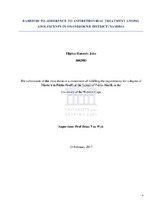| dc.contributor.advisor | Van Wyk, Brian | |
| dc.contributor.author | Eliphas, Hatutale John | |
| dc.date.accessioned | 2017-07-19T10:39:29Z | |
| dc.date.available | 2017-07-19T10:39:29Z | |
| dc.date.issued | 2017 | |
| dc.identifier.uri | http://hdl.handle.net/11394/5486 | |
| dc.description | Master of Public Health - MPH | en_US |
| dc.description.abstract | Poor adherence to antiretroviral therapy (ART) among paediatric and adolescent patients remains a big concern to health workers at Onandjokwe CDC clinic in Oshikoto Region of Namibia. Despite successes in the scale up of ART in Oshikoto Region the clinic experienced high prevalence of poor adherence to ART among adolescent patients. Out of 631 adolescents alive and on ART in this clinic, 154 (24%) had records of poor drug adherence between Jan 2015 and August 2015; which compared poorly to only 4 % of 7289 adults currently on ART who have records of poor adherence during the same period. The aim of the current study was to explore barriers to adherence to antiretroviral therapy among these adolescents. Among the study population of 631 adolescents on ART in Onandjokwe, a sample population of 154 had records of poor adherence (scored below 85%) to ART between June 2015 and August of the same year were considered for the study but among them 16 adolescents were recruited as the
study sample. Additionally, 5 caregivers of adolescents on ART, 6 Healthcare Providers were selected as key informants. A voice recorder and field notes were being used during data collection. Two 2 sessions of Focus Group Discussions (FGD) were held with adolescents while 2 FGD sessions held with 5 caregivers and 6 healthcare providers to elicit expert opinions. Lastly, 5 In-depth interviews were conducted with individual adolescents who missed ART medicine follow up for 1 month or more between January and August of 2015. Data Analysis was performed using hand manipulation by grouping responses into main study objectives/themes. Data cleaning, translation of voice transcription from Oshiwambo to English
language and incorporating of non-verbal expressions was also done. The results indicate that factors contributing to poor ART adherence among adolescents are patient and family related, socio-economic, and related to substance abuse, stigma and discrimination, health care and health systems, as well as the environment and weather. | en_US |
| dc.language.iso | en | en_US |
| dc.publisher | University of the Western Cape | en_US |
| dc.subject | Antiretroviral therapy (ART) | en_US |
| dc.subject | Adolescents | en_US |
| dc.subject | Adherence to antiretroviral therapy | en_US |
| dc.subject | Namibia | en_US |
| dc.subject | Oshikoto Region (Namibia) | en_US |
| dc.title | Barriers to adherence to antiretroviral treatment among adolescents in Onandjokwe district, Namibia | en_US |
| dc.rights.holder | University of the Western Cape | en_US |

